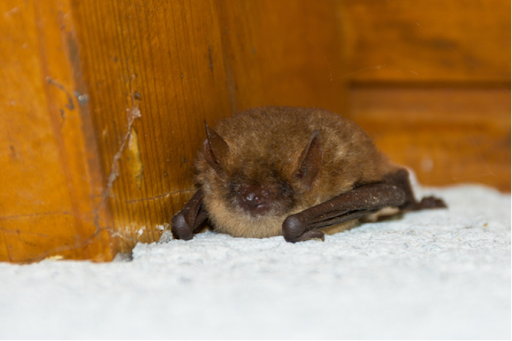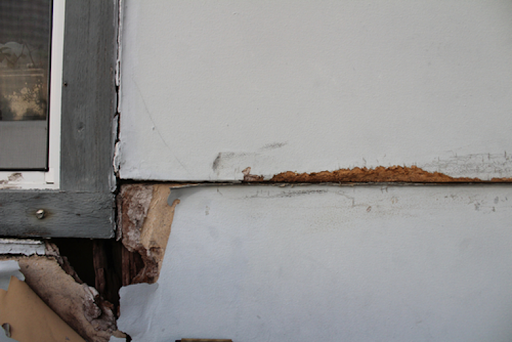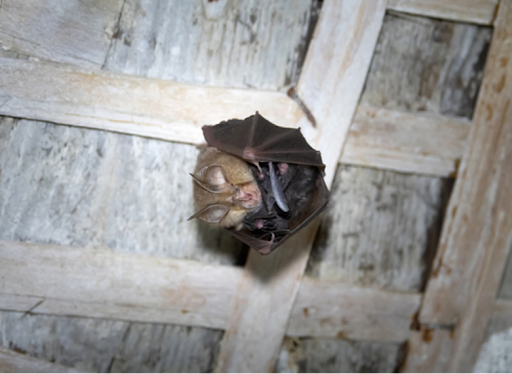Houses provide bats with the ideal winter hideaway, offering warmth and protection from predators during hibernation. While this may suit them, it’s far from ideal for you. If you suspect a bat infestation, it’s crucial to take the right steps to address the issue.
To safely remove bats and prevent them from returning, it helps to understand these winged creatures better. That’s why the experts at Varment Guard have created this guide to bat behavior and practical tips for keeping them out of your home.
Can Bats Survive in Cold Weather?
Bats cannot survive freezing temperatures (even when they’re hibernating). So, how warm does it have to be for a bat to survive? Any roost bats shelter in for the winter must be at least 45 degrees, which is why folks often find bats in their garage in winter.
Do Bats Hibernate? How Active Are They in Winter?
Bat hibernation is unique because they can enter their inactive state (torpor) for variable lengths of time. The common little brown bat can hibernate for 6 months or enter torpor for just a few hours.
Bats can wake up out of torpor while hibernating more frequently than some animals. Their body temperature rapidly returns to normal and they can fly and hunt for food. Bats frequently wake up on warm winter days.

Infestation Issues: The Dangers of Bats Entering Your House in the Winter
Unfortunately, your attic meets every requirement that bats need for their winter roosts. Bats can become a serious problem in the winter when they use your home as an over-wintering spot. A bat infestation can cause the following problems:
Structural Damage
Bats and their guano can cause significant structural damage to residential homes, particularly to insulation and ceilings. Guano accumulates quickly in areas where bats roost, compressing and saturating insulation, reducing its effectiveness and leading to higher energy costs. Over time, the weight of the guano can strain ceilings, potentially causing sagging or even collapse in severe cases. Additionally, the ammonia-rich waste can stain walls and ceilings, creating unsightly discoloration and unpleasant odors that permeate the home. Prompt removal and remediation are essential to mitigate these damages.
Disease Transmission
Rabies:If a person or animal is bitten by a bat, immediate medical attention is essential. A physician or veterinarian should evaluate the situation, and if possible, the bat should be safely collected and tested for rabies. Never handle bats, even if they appear healthy, as they can still carry and transmit the virus.
Histoplasmosis:This respiratory infection is caused by inhaling fungal spores found in bat guano (droppings). When bats infest areas like attics, basements, or walls, their droppings can accumulate and pose serious health risks. Proper removal and cleanup by professionals are vital to ensure your safety and prevent exposure to harmful waste.
Unpleasant Odors
A strong, unpleasant odor often signals a bat infestation and is usually caused by the accumulation of bat urine and guano.
If Bats Hibernate in the Winter, Why Are They Flying Around My House?
While the bats are hibernating, they remain motionless. In fact, they’re so still, you might not even realize they’re in your house. They likely won’t stay this way all winter, though. Instead, they’ll wake up periodically, hungry, thirsty, and often confused. This is likely the state the animal will be in if you find a bat flying around your house during the winter.
When bats fly around your house, they can produce unsanitary waste in and around their roosts. Although it’s very rare, confused and frightened bats may also bite people in your home.
How are Bats Getting Into My House?
Bats commonly enter homes through:
1. Small Openings
Bats enter homes by squeezing through small openings; bats can fit into a hole as small as ½”. A good rule of thumb (or pinky finger), is that if you can stick your pinky finger in an opening, a bat can squeeze through it.
2. High Up Spaces
Openings that bats get through tend to be up high, on siding, roofing and awnings, along utility lines, and around window frames.
3. Damage in the Home
Bats also often fly through unscreened vents or chimneys. Torn screens and vents, loose shingles, missing chimney caps, and rotting siding are all common bat-exploitable openings.
Bats may also inflict minor damage of their own to get inside. They’ve been known to squeeze through thin layers of insulation or punch through damaged weatherproofing.

How Do I Keep Bats Out of My House This Winter?
Excluding bats this winter is all about cutting off their access points. To make sure bats don’t bother you this season, follow these tips:
- Inspect bat-vulnerable areas like your attic, crawl spaces, rafters, and basement. Look for any signs of structural damage and openings.
- Use caulk or other tools to repair the openings. Pay attention to corners, baseboards, and window frames.
- Look for any unscreened exhaust vents or chimneys. Install any screens to block off access quickly and easily.
- Walk the perimeter of your home. Look for any signs of damage that bats may use to squeeze inside. Make sure you look for any gaps between utilities like downspouts, gutters, chimneys, or pipes.

No Such Thing as DIY: Professional Pest Control For Bats is a Must
Intentionally harming bats is illegal, but removal from your home is not. For your safety and the bat’s safety, bats should only be handled by a wildlife professional. Our team ensures we’re removing a bat colony without harming them or your home. In addition to bat removal, we provide clean-out and restoration services after an infestation.
Bat Removal in Winter: Get Help From the Pest Control Experts at Varment Guard
If you follow the exclusion tips above and you’re still struggling with bats in your home, get in touch with Varment Guard today. We can get and keep bats out and prevent future infestations.







